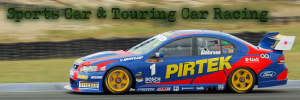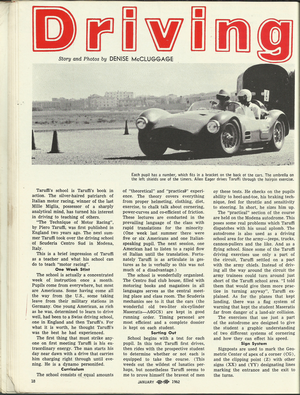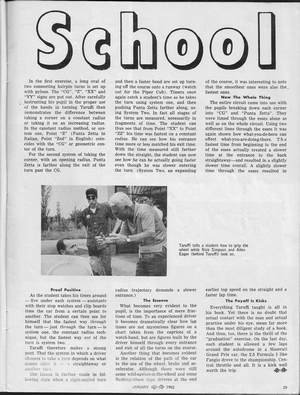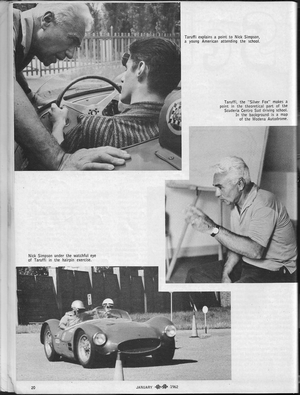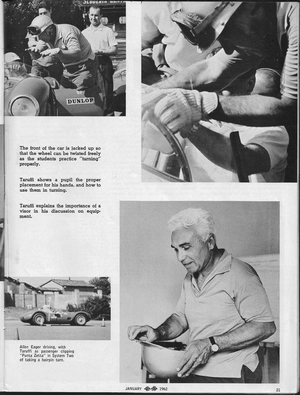|
By accessing or using The Crittenden Automotive Library™/CarsAndRacingStuff.com, you signify your agreement with the Terms of Use on our Legal Information page. Our Privacy Policy is also available there. |

Driving School
|
|---|
|
|
Driving School
Denise McCluggage
Today's Motor Sports
January 1962
Taruffi's school is Taruffi's book in action. The silver-haired patriarch of Italian motor racing, winner of the last Mille Miglia, possessor of a sharply analytical mind, has turned his interest in driving to teaching of others.
"The Technique of Motor Racing", by Piero Taruffi, was first published in England two years ago. The next summer Taruffi took over the driving school of Scuderia Centro Sud in Modena, Italy.
This is a brief impression of Taruffi as a teacher and what his school can do to teach "motor racing".
One Week Stint
The school is actually a concentrated week of instruction once a month. Pupils come from everywhere, but most are Americans. Some having come all the way from the U.S., some taking leave from their military stations in Germany. One young American, as rich as he was, determined to learn to drive well, had been to a Swiss driving school, one in England and then Taruffi's. For what it is worth, he thought Taruffi's was the best he had experienced.
The first thing that must strike anyone on first meeting Taruffi is his extraordinary energy. The man starts his day near dawn with a drive that carries him charging right through until evening. He is a dynamo personified.
Curriculum
The school consists of equal amounts of "theoretical" and "practical" experience. The theory covers everything from proper helmeting, clothing, diet, exercise, to chalk talk about cornering, power-curves and co-efficient of friction. These lectures are conducted in the prevailing language of the class with rapid translations for the minority. (One week last summer there were five or six Americans and one Italian-speaking pupil. The next session, one American had to listen to a rapid flow of Italian until the translation. Fortunately Taruffi is as articulate in gestures as he is verbally so this was not much of a disadvantage.)
The school is wonderfully organized. The Centro Sud club house, filled with motoring books and magazines in all languages serves as the central meeting place and class room. The Scuderia mechanics see to it that the cars (the wonderful old two-liter six-cylinder Maseratis—A6GCS) are kept in good running order. Timing personnel are most efficient and a complete dossier is kept on each student.
Sorting Out
School begins with a test for each pupil. In this test Taruffi first drives, then rides with the prospective student to determine whether or not each is equipped to take the course. (This weeds out the wildest of lunatics perhaps, but nonetheless Taruffi seems to me to prove himself the bravest of men by these tests. He checks on the pupils ability to heel-and-toe, his braking technique, feel for throttle and sensitivity to steering. In short, he sizes him up.
The "practical" section of the course are held on the Modena autodrome. This poses some real problems which Taruffi dispatches with his usual aplomb. The autodrome is also used as a driving school for the army—jeeps, trucks, cannon-pullers and the like. And as a flying school. Since some of the Taruffi driving exercises use only a part of the circuit, Taruffi settled on a pact with the army chiefs. Instead of driving all the way around the circuit the army trainees could turn around just short of the Taruffi school area. "I told them that would give them more practice in turning anyway", Taruffi explained. As for the planes that kept landing, there was a flag system of warning that kept the student Maseratis far from danger of a land-air collision.
The exercises that use just a part of the autodrome are designed to give the student a graphic understanding of two different systems of cornering and how they can affect his speed.
Sign System
Signposts are used to mark the Geometric Center of apex of a corner (CG), and the clipping point (Z) with other signs (XX) and (YY) designating lines marking the entrance and the exit to the turns.
In the first exercise, a long oval of two connecting hairpin turns is set up with pylons. The "CG", "Z", "XX" and "YY" signs are put out. After carefully instructing his pupil in the proper use of the hands in turning Taruffi then demonstrates the difference between taking a corner on a constant radius or taking it on an increasing radius. In the canstant radius method, or system one, Point "Z" (Punta Zetta in Italian, Point "Zed" in English) coincides with the "CG" or geometric center of the turn.
For the second system of taking the corner, with an opening radius, Punta Zetta is farther along the exit of the turn past the CG.
Proof Positive
As the student takes his times around — five under each system — assistants with their stop watches and clip boards time the car from a certain point to another. The student can then see for himself that the fastest way
through the turn — just
through the turn — is system one, the constant radius technique. But the fastest way out of the corner is system two.
Taruffi therefore makes a strong point. That the system in which a driver chooses to take a turn depends on what comes after it — a straightaway or another turn.
The lesson is further made in following days when a right-angled turn and then a faster bend are set up turning off the course onto a runway (watch out for the Piper Cub). Timers once again catch a student's time as he takes the turn using system one, and then pushing Punta Zetta farther along, using System Two. In fact all stages of the turns are measured, necessarily in fragments of time. The student can thus see that from Point "XX" to Point "ZZ" his time was fastest on a constant radius. He can see how his entrance time more or less matched his exit time. With the time measured still farther down the straight, the student can now see how he can actually be going faster even though he was slower entering the turn. (System Two, an expanding radius trajectory, demands a slower entrance.)
The Essence
What becomes very evident to the pupil, is the importance of mere fractions of time. To an experienced driver it becomes dramatically clear how lap times are not mysterious figures on a chart taken from the caprices of a watch-hand, but are figures built by the driver himself through every entrance and exit of all the turns on the course.
Another thing that becomes evident is the relation of the path of the car to the use of the wheel, brake, and accelerator. Although there were still some wild-sawers-at-the-wheel and some flashing-elbow type drivers at the end of the course, it was interesting to note that the smoothest ones were also the fastest ones.
Now The Whole Thing
The entire circuit came into use with the pupils breaking down each corner into "CG" and "Punta Zetta". They were timed through the esses alone as well as on the whole circuit. Using two different lines through the esses it was again shown how what-you-do-here can effect what-you-are-doing-there. The fastest time from beginning to the end of the esses actually created a slower time at the entrance to the back straightaway—and resulted in a slightly slower time overall. A slightly slower time through the esses resulted in earlier top speed on the straight line and a faster lap time.
The Payoff Is Kicks
Everything Taruffi taught is all in his book. Yet there is no doubt that actual contact with the man and actual practice under his eye, mean far more than the most diligent study of a book. And then, too, there is the thrill of the "graduation" exercise. On the last day, each student is allowed a few laps around the autodrome in a Maserati Grand Prix car, the 2.5 Formula I like Fangio drove to the championship. Center throttle and all. It is a kick well worth the trip.

















